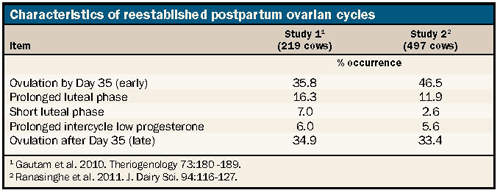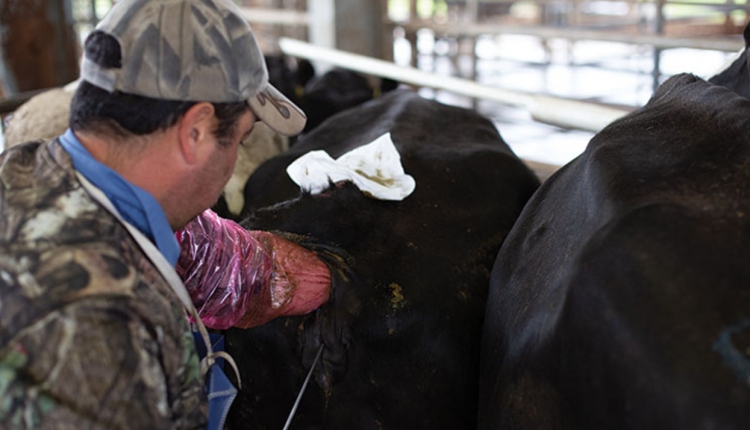The author is professor of animal sciences at Kansas State University, Manhattan.
Reestablishing estrous cycles after calving has been studied since the 1920s. Back then, Sir John Hammond of Cambridge made some of the first recorded observations in dairy cattle. Early studies estimating when normal estrous cycles resumed were based on visual detection of estrus, palpation of the ovaries, or both.
Later, with the use of blood or milk progesterone immunoassays, onset of progesterone secretion by the first postpartum luteal structure or corpus luteum could be determined by scientists. With these tools, research has focused on when and how first ovulation occurs and what factors are possibly controlling (stimulating or inhibiting) the first luteal function in the dairy cow.
As we delve deeper into this topic, let's begin by defining some terms. Then, we will examine some of the recently identified factors that are associated with first postpartum estrous cycles.
Confusing terms
A number of terms are used interchangeably when describing the onset of postpartum estrous cycles. Anestrus literally means lack of estrus or estrous cycles - a common occurrence during pregnancy. This term can be confused with anovulation which is the lack of regular estrous cycles each associated with ovulation.
For example, a cow may be defined as anestrous but having regular ovulatory cycles when she does not display any heat signs before ovulation. Furthermore, a cow may be anovulatory (no ovulation) but displaying regular signs of heat. The former (anestrus but ovulating regularly) is very common. It indicates a lack of good heat detection on the farm.
Most of these situations come down to a people problem: Somebody thinks everybody is watching cows, but nobody is doing it! In other cases, it is a cow problem because cows are not showing heats. The latter problem, no ovulation but showing heat, is rare, generally only taking place when cows have follicular cysts. For more details on ovarian cysts, see the January 10, 2012, issue on page 21.
Recently, other descriptors used in the scientific literature include the terms ovular and anovular. Ovular cows have reestablished estrous cycles after calving and are ovulating at regular intervals (every 20 to 22 days), irrespective of behavioral estrus. On the other hand, anovular cows have not reestablished estrous cycles and are not having normal ovulatory cycles.
Recent studies in Japan have shed new light on this old story. Researchers chose to define delayed postpartum resumption of ovarian activity based on its relationship to reduced pregnancy rates.
They studied 219 cows in four commercial herds and monitored ovarian activity by collecting milk samples twice weekly and measuring progesterone. Where other researchers arbitrarily chose some threshold cutoff for cows that were considered to have delayed or nondelayed first postpartum ovulation, the Japanese study determined in these herds that the threshold to define delayed ovulation was 35 days because cows ovulating after that time had reduced fertility.

The table illustrates two studies by these authors summarizing some characteristics of postpartum cows as they first ovulate and resume estrous cycles. Note that fewer than 50 percent of cows had resumed estrous cycles by 35 days in milk - not different from studies in the U.S. From 12 to 16 percent of cows had prolonged luteal phases after ovulation had occurred.
Prolonged luteal phases were defined as periods exceeding 20 days when progesterone concentrations were elevated (> 5 ng/mL) in the absence of insemination. These prolonged luteal periods occurred because the corpus luteum was maintained and failed to regress. Short luteal phases (3 to 7 percent) were characterized by shorter than normal luteal function after ovulation, except for the first estrous cycle which is typically shorter than 20 days in dairy cows.
Prolonged intercycle low progesterone (6 percent) represented periods of at least 14 days between either the first and second cycle or between the second and third cycle. Normally, a period of 7 to 9 days of low progesterone exists from the time of luteal regression of one cycle until after estrus when the new corpus luteum becomes functional in the next cycle. Approximately one-third of dairy cows did not ovulate until after 35 days in milk.
Cows that ovulated after Day 35 in milk and those with prolonged intercycle low progesterone concentrations were associated with 50 and 65 percent reduction in pregnancy rates, respectively, compared with cows that resumed estrous cycles by Day 35. Furthermore, cows that did not ovulate before Day 35 in milk were less likely to conceive to first A.I. and less likely to become pregnant by 100 or 210 days in milk. Days open for late-ovulating cows (213 days) and for those with prolonged intercycle low progesterone (220 days) were greater than for early ovulating cows (152 days).
In the second study highlighted in the table, incidence of prolonged luteal phases (before any A.I.) after ovulation ranged from 9 to 17 percent in three herds. More than 64 percent of these luteal phases occurred after first postpartum ovulation, 31 percent after second ovulation, and 5 percent after third ovulation. Approximately 83 percent of these prolonged luteal phases were 20 to 28 days in duration.
These cows had reduced conception rates to first A.I. and fewer were pregnant by 100, 150, or 210 days in milk. Multilactation cows, compared with 2-year-olds, were three times more likely to have prolonged luteal phases. The other most important risk factor for prolonged luteal phases was postpartum complications and health disorders.
Cows to monitor
In summary, based on these two studies, more than 50 percent of dairy cows are at risk for poorer fertility when they have delayed resumption of ovulation and abnormal characteristics of postpartum estrous cycles (prolonged intercycle low progesterone and prolonged luteal phases) compared with cows that resume normal estrous cycles by Day 35 in milk.
Some of the risk factors include fresh cow health disorders and age. Fresh cow care, including clean calving areas, monitoring transition cows closely for subclinical signs of ketosis and milk fever, and adequate dry matter intakes, will likely reduce some of these risk factors for late ovulation. Happy A.I. breeding!
Click here to return to the Reproduction E-Sources
120210_90
Reestablishing estrous cycles after calving has been studied since the 1920s. Back then, Sir John Hammond of Cambridge made some of the first recorded observations in dairy cattle. Early studies estimating when normal estrous cycles resumed were based on visual detection of estrus, palpation of the ovaries, or both.
Later, with the use of blood or milk progesterone immunoassays, onset of progesterone secretion by the first postpartum luteal structure or corpus luteum could be determined by scientists. With these tools, research has focused on when and how first ovulation occurs and what factors are possibly controlling (stimulating or inhibiting) the first luteal function in the dairy cow.
As we delve deeper into this topic, let's begin by defining some terms. Then, we will examine some of the recently identified factors that are associated with first postpartum estrous cycles.
Confusing terms
A number of terms are used interchangeably when describing the onset of postpartum estrous cycles. Anestrus literally means lack of estrus or estrous cycles - a common occurrence during pregnancy. This term can be confused with anovulation which is the lack of regular estrous cycles each associated with ovulation.
For example, a cow may be defined as anestrous but having regular ovulatory cycles when she does not display any heat signs before ovulation. Furthermore, a cow may be anovulatory (no ovulation) but displaying regular signs of heat. The former (anestrus but ovulating regularly) is very common. It indicates a lack of good heat detection on the farm.
Most of these situations come down to a people problem: Somebody thinks everybody is watching cows, but nobody is doing it! In other cases, it is a cow problem because cows are not showing heats. The latter problem, no ovulation but showing heat, is rare, generally only taking place when cows have follicular cysts. For more details on ovarian cysts, see the January 10, 2012, issue on page 21.
Recently, other descriptors used in the scientific literature include the terms ovular and anovular. Ovular cows have reestablished estrous cycles after calving and are ovulating at regular intervals (every 20 to 22 days), irrespective of behavioral estrus. On the other hand, anovular cows have not reestablished estrous cycles and are not having normal ovulatory cycles.
Recent studies in Japan have shed new light on this old story. Researchers chose to define delayed postpartum resumption of ovarian activity based on its relationship to reduced pregnancy rates.
They studied 219 cows in four commercial herds and monitored ovarian activity by collecting milk samples twice weekly and measuring progesterone. Where other researchers arbitrarily chose some threshold cutoff for cows that were considered to have delayed or nondelayed first postpartum ovulation, the Japanese study determined in these herds that the threshold to define delayed ovulation was 35 days because cows ovulating after that time had reduced fertility.

The table illustrates two studies by these authors summarizing some characteristics of postpartum cows as they first ovulate and resume estrous cycles. Note that fewer than 50 percent of cows had resumed estrous cycles by 35 days in milk - not different from studies in the U.S. From 12 to 16 percent of cows had prolonged luteal phases after ovulation had occurred.
Prolonged luteal phases were defined as periods exceeding 20 days when progesterone concentrations were elevated (> 5 ng/mL) in the absence of insemination. These prolonged luteal periods occurred because the corpus luteum was maintained and failed to regress. Short luteal phases (3 to 7 percent) were characterized by shorter than normal luteal function after ovulation, except for the first estrous cycle which is typically shorter than 20 days in dairy cows.
Prolonged intercycle low progesterone (6 percent) represented periods of at least 14 days between either the first and second cycle or between the second and third cycle. Normally, a period of 7 to 9 days of low progesterone exists from the time of luteal regression of one cycle until after estrus when the new corpus luteum becomes functional in the next cycle. Approximately one-third of dairy cows did not ovulate until after 35 days in milk.
Cows that ovulated after Day 35 in milk and those with prolonged intercycle low progesterone concentrations were associated with 50 and 65 percent reduction in pregnancy rates, respectively, compared with cows that resumed estrous cycles by Day 35. Furthermore, cows that did not ovulate before Day 35 in milk were less likely to conceive to first A.I. and less likely to become pregnant by 100 or 210 days in milk. Days open for late-ovulating cows (213 days) and for those with prolonged intercycle low progesterone (220 days) were greater than for early ovulating cows (152 days).
In the second study highlighted in the table, incidence of prolonged luteal phases (before any A.I.) after ovulation ranged from 9 to 17 percent in three herds. More than 64 percent of these luteal phases occurred after first postpartum ovulation, 31 percent after second ovulation, and 5 percent after third ovulation. Approximately 83 percent of these prolonged luteal phases were 20 to 28 days in duration.
These cows had reduced conception rates to first A.I. and fewer were pregnant by 100, 150, or 210 days in milk. Multilactation cows, compared with 2-year-olds, were three times more likely to have prolonged luteal phases. The other most important risk factor for prolonged luteal phases was postpartum complications and health disorders.
Cows to monitor
In summary, based on these two studies, more than 50 percent of dairy cows are at risk for poorer fertility when they have delayed resumption of ovulation and abnormal characteristics of postpartum estrous cycles (prolonged intercycle low progesterone and prolonged luteal phases) compared with cows that resume normal estrous cycles by Day 35 in milk.
Some of the risk factors include fresh cow health disorders and age. Fresh cow care, including clean calving areas, monitoring transition cows closely for subclinical signs of ketosis and milk fever, and adequate dry matter intakes, will likely reduce some of these risk factors for late ovulation. Happy A.I. breeding!
120210_90










